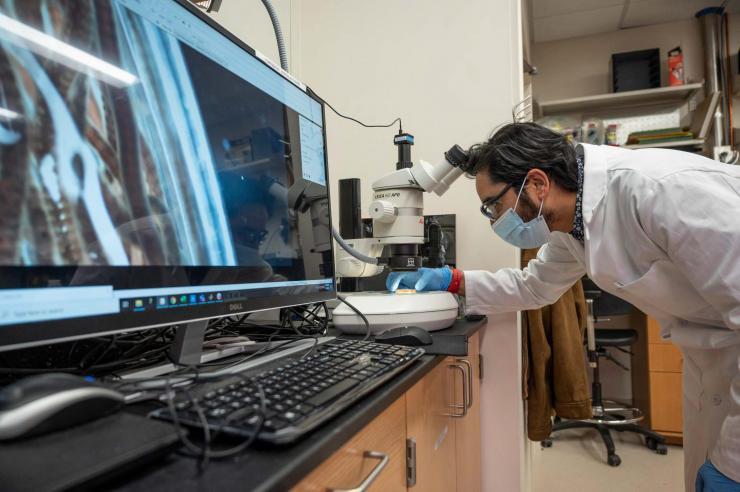Biomolecular Engineer Wins Grant to Make Microorganism-Inspired Machines
Oct 12, 2021 — Atlanta, GA

Saad Bhamla repositions a slide for a microscope
What do the cylinder in an internal combustion engine and the four-millimeter-long creature, Spirostomum ambiguum, have in common? Surprisingly, quite a bit. Both are similarly shaped. Both shrink to a fraction of their size in an instant. And both release about the same amount of power output per cubic centimeter in volume. But for all we know about the engine, we know relatively little about the living organism.
Saad Bhamla, a professor in the School of Chemical and Biomolecular Engineering at Georgia Tech, recently received an Outstanding Investigator Award from the National Institute of General Medical Sciences, part of the National Institutes of Health, to continue studying Spirostomum and attempt to build machines based on similar principles. The grant will provide his research group with $1.98 million in funding over five years.
For Bhamla, the comparison between the organism and the engine is more than just an analogy. He is now working to build something directly akin to a micro-engine, with pistons and cylinders made out of synthetic cells similar to Spirostomum.
“That's basically the stuff of my dreams,” Bhamla said.
Once built, he believes that these molecular engines might prove far more efficient than other miniaturized power sources. The chief difficulty will be making a synthetic cell that functions like Spirostomum, Bhamla said. Today, most synthetic cells do very different things, like producing lab-grown meat.
“We still think of them as basically bags of fluid,” said Bhamla. “They don't move, they just hang around in test tubes.”
Over the last few years, Bhamla and colleagues have learned more about how Spirostomum works. Its capabilities come from its use of an unconventional fuel, calcium, rather than adenosine triphosphate (ATP), the molecule that powers most human cells.
In a preprint from 2019, Bhamla and Xinjing Xu, then an undergraduate student at Georgia Tech, figured out exactly what makes the organism contract. They found that when calcium binds to Spirostomum’s skeletal mesh, it forces each cell of the skeleton to coil tight.
One of Bhamla’s current doctoral students, Xiangting Lei, is already examining how to replicate this mechanism in a synthetic cell. She is investigating how to give the cell external triggers so that engineers can make it contract whenever they want. Bhamla plans to use the funds from the grant to hire several more graduate students to study these systems.
The goal is to create modern versions of what were historically known as mechanochemical machines. A rich literature on these chemically-powered machines had been created in the sixties, only to be forgotten, Bhamla said. It seemed to be a classic case of science getting ahead of itself.
“They didn't have the right optical tools and soft materials to do this,” said Bhamla. “This is a great time to revisit [the research] because I think this time, we might be able to have much more success.”
About Georgia Tech
The Georgia Institute of Technology, or Georgia Tech, is a top 10 public research university developing leaders who advance technology and improve the human condition. The Institute offers business, computing, design, engineering, liberal arts, and sciences degrees. Its nearly 40,000 students representing 50 states and 149 countries, study at the main campus in Atlanta, at campuses in France and China, and through distance and online learning. As a leading technological university, Georgia Tech is an engine of economic development for Georgia, the Southeast, and the nation, conducting more than $1 billion in research annually for government, industry, and society.
Mordechai Rorvig
Senior Science Writer
Georgia Institute of Technology




